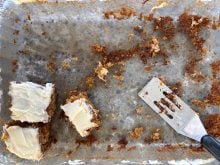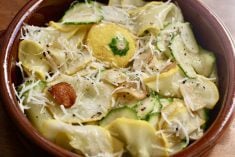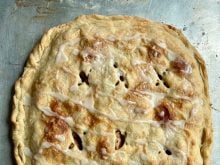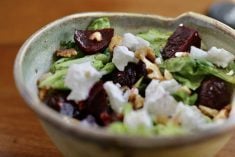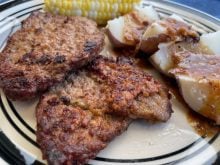Canada’s 100th birthday in 1967 seemed to be an appropriate time to explore and enjoy the exciting recipes that made up the Canadian cuisine culture.
Emmie Oddie’s “I’d Like To Know?” column in The Western Producer received numerous request for recipes that reflected this heritage for use at centennial buffets, family gatherings and picnics.
One reader inquired about specific provincial and regional dishes to include in their menu for a community centennial banquet. Oddie gave the following suggestions in her April 6, 1967, column.
Read Also

VIDEO: Bittersweet harvest for this family farmhand
Bruce Burnett helps his brother harvest wheat and canola for the last time on the family farm in Manitoba where they both grew up.
All of the Maritime provinces are known for their seafood, specifically Newfoundland and Labrador for cod fish cakes and lobster salad, salmon from the Gaspe and Restigouche regions, Digby chicks, which are salted smoked fillets of herring that are useful when making hors d’oeuvres, and an oyster stew.
Prince Edward Island is known for potatoes and fruit from the Annapolis Valley. Quebec has many provincial dishes, such as French Canadian pea soup and traditional Christmas tourtière (pork pies). Oka cheese could be served on a relish tray. Maple syrup is produced in both Quebec and Ontario.
These maple syrup tarts would make an easy addition for a dessert table or picnic basket.
Maple syrup tarts
Yields: 30 mini tarts.
- 1 large egg
- 1 cup maple syrup
- 1/2 cup pecans, chopped
Use a favourite pie pastry, roll and cut to make tart shells, or use frozen premade tart shells. Refrigerate shells to chill before filling.
Preheat oven to 425 F.
For the filling, place the egg in a measuring cup or jug and beat well with a fork, add syrup, stir to mix. Divide pecan pieces between tarts. Pour syrup mixture into shells, about two-thirds full. Bake in preheated oven for five minutes and then lower heat to 325 F and bake 20 to 25 minutes until pastry is golden and filling is set. Cool on a wire rack.
For something quite different, serve fiddleheads, which are fern fronds picked and boiled like asparagus. They could be used on bread like a canape.
Ontario was settled by United Empire Loyalists moving from the American colonies. They brought along their original English habits plus a few adopted ones such as Thanksgiving turkey.
Many others have contributed food customs to Ontario — Germans, Irish, Scottish, Dutch, Italians and Jewish people all brought special foods. Possible Italian dishes to serve are chicken cacciatore, chicken tetrazzini or pizza and sour cream apple pie for the German group. Pickled peppers or blueberry pie or muffins could also be considered.
For the prairie provinces, there are numerous national dishes from the kitchens of the settlers who poured into the west.
Winnipeg is famous for Winnipeg Goldeye. In Saskatchewan, cabbage rolls are often served at potluck suppers. Chinese food became popular due to the main street restaurants of most prairie towns. Rice, sweet and sour dishes and egg rolls would all make good buffet items.
Other prairie options are borscht (beet soup), nesu (Finnish coffee bread) and rullu pylsa, an Icelandic spiced meat loaf that could be served as a buffet meat or as hors d’oeuvres.
Alberta is renowned for beef, but make sure to select the best cut.
Another native prairie food would be saskatoon berries in pies or as a relish.
Halibut could well represent British Columbia, or an apple tuna fish salad or refreshing apple juice. Also, anything with B.C. tree fruits such as a fruit cup, salad or fruit pies. For The Yukon and Northwest Territories, sourdough bread or muffins would complete a national buffet.
In her March 30, 1967 article, Oddie shared some recipes from an almost 100-year-old cookbook. She said that “perhaps not useful, but the recipes displayed an interesting style.” She described the book as “entered according to an Act of the Parliament of Canada in the year 1877 by Bedford Brothers, in the office of the minister of agriculture.”
In the 1800s, recipes were not as precise or easily written as they are today. Generally, the recipe was written in one long sentence with commas. This would make it very difficult to follow the ingredient list. The following lemon pie recipe was an example from the 1877 cookbook.
Lemon pie
“One lemon rind and juice, one cup of sugar, one cup of water, one tablespoon of cornstarch cooked in water until thick, three eggs, two of whites saved for frosting, half cup of sugar.”
Terse, but that’s it, the whole recipe. Recipes presented only the essentials. Cooks learned from cooks, so there was no need for unnecessary words.
German honey cakes (cookies)
This recipe was given to Oddie’s mother by a long-time family friend, Mr. Phillip Hartz, who lived just south of Saskatoon.
- 4 cups honey
- 1/2 pound butter
- 1/2 cup lard
- 3 tsp. cinnamon
- 1 tsp. allspice
- 1/2 tsp. nutmeg
- 1/4 tsp. pepper
- 1/2 tsp. salt
- 1/4 cup milk
- 2 tbsp. soda
- 8 cups flour, approximately
Melt together the honey, butter and lard.
Add other ingredients and mix well.
Let stand in a cool place for several days.
Take a little at a time, work well, roll out, cut into cookies.
Bake in a slow oven, about 300 F for eight to 12 minutes, depending on thickness of cookie.
These German cakes improve with age.
The recipe was published in the June 1, 1967, issue of The Western Producer. A reader asked Oddie for pizza recipes that could be made at home rather than buying one of the new packaged pizza mixes. In her response she commented that with almost 500,000 people of Italian origin in Canada in 1967, it is not surprising that pizza has found its way into Canadian culture.
Pizza was also a food that many Canadian military personnel were introduced to during the Second World War.
In the 1960s, pizza parlours or restaurants became popular hangout places for teenagers.
Pizza Siciliana (roughly translated as Sicilian tomato pie)
- 1 envelope yeast 8 g
- 1 cup lukewarm water
- 3-4 cups flour
- 1 tsp. salt
- 2 tbsp. peanut or olive oil
- anchovy tomato sauce
- 1/2 cup Italian mozzarella cheese, grated
Dissolve yeast in lukewarm water. Place three cups flour and salt on a board. Add dissolved yeast and knead thoroughly for 10 minutes, adding more flour as needed. Add oil and continue kneading until smooth.
Cover well. Set aside in a warm place for two hours or until dough doubles in size. Pound dough, cover and set aside for another half hour.
Spread dough about half an inch thick in a large well-greased cookie sheet. Or use a round pizza pan, which will give a thicker dough. Dent here and there with fingertips. Cover and set aside for half an hour.
Pour a generous layer of anchovy tomato sauce over dough and sprinkle liberally with grated cheese.
Bake in a hot 425 F oven for 25 to 30 minutes. Lower heat to 375 F and continue baking 15 minutes or until pizza is golden brown.
Remove from oven and cut into pieces about four to five inches square. Serve hot.
Anchovy tomato sauce
- 1 large onion, diced
- 3 tbsp. olive oil
- 1 can tomato paste 156 mL
- 1/2 tsp. oregano
- 3 anchovy fillets or 1 1/2 tsp. anchovy paste
- 1/2 cup water
- 1 tsp. sugar
- salt and pepper to taste
Fry onion in oil on medium heat about five minutes or until medium brown.
Add paste and fry for three minutes, stirring constantly. Add oregano, anchovies, water, sugar, salt and pepper. Cover and simmer over low heat for 25 minutes.
Adapted from Emmie Oddie’s recipe from Feb. 9, 1967.
Oddie goes on to state that bread dough or baking powder biscuit dough can also be used as the base for the pizza. The toppings can vary, including cooked sausage, mushrooms, green pepper, shrimp, olives, wieners and bacon. Cheeses can vary from mozzarella, cheddar or processed cheese to a combination of parmesan, mozzarella and romano cheese.
Betty Ann Deobald is a home economist from Rosetown, Sask., and a member of Team Resources. Contact: team@producer.com.






